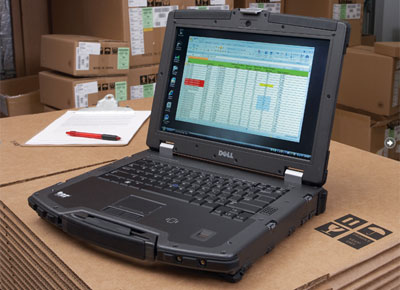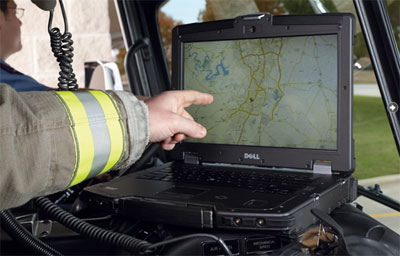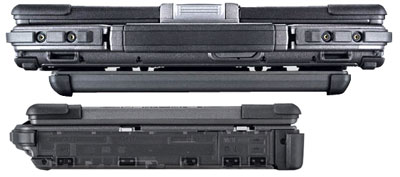On March 10, 2009, almost exactly a year after Dell introduced the impressive Latitude XFR D630, the company unveiled the Latitude E6400 XFR. This new machine represents another step in Dell's efforts to make an entry in the increasingly competitive and important rugged notebook market.

While the original Latitude ATG ("All Terrain Grade"), introduced in January of 2007, was a somewhat half-hearted effort that lacked clearly stated ruggedness specs, the follow-up ATG D630 differentiated itself with a superb outdoor-viewable display technology called DirectVue, but it still wasn't rugged. Next came the entirely more serious Latitude XFR D630, a machine that appeared to be based on the Augmentix/Dell XTG630. Augmentix certainly knew what they were doing. We commented that "Dell also seems to have taken a crash course in how to present and sell rugged machines. Whereas the initial efforts lacked both ruggedness and decipherable ruggedness certification data, Dell now provides a very detailed description of all the independent testing and validation performed on the machine." With the new E6400 XFR, Dell continues along those lines, and then some.
So what is the E6400 XFR all about? It is a heavily ruggedized notebook that's based on Dell's consumer market Latitude E6400, but one that claims an impressive IP65 ingress protection rating, a 3-foot operational drop spec, and successful passing of no fewer than 13 military standard MIL-STD-810F testing procedures and a variety of additional and very relevant tests.
While the consumer version weighs just 4.3 pounds, the fortified XFR is an 8.5-pound notebook with a 13.9 x 10.1 inch footprint. It is 2.2 inches thick, has a 14.1-inch 1280 x 800 wide-format display that uses the DirectVue display enhancement that RuggedPCReview called the best available solution for a non-touchscreen outdoor viewability display when we reviewed the predecessor XTG630 in late 2007. A resistive touch screen is available as a US$500 option.

The XFR D630 can be equipped with either an Intel Core 2 Duo P8700 (2.53GHz) or a Core 2 Duo P9600 (2.66GHz) processor and with up to 8GB (when using a 64-bit OS) of 800MHz DDR2 RAM. A 64GB solid state disk comes standard, doubtlessly aiding standard model ruggedness specs. The cost structure of solid state drives has changed as well--getting a shock-mounted 120GB 5400ROM hard disk costs $99 more than the SSD whereas with the predecessor machine, the 64GB SSD was a $500 option over the standard hard disk. SSDs sure have come down in price.
Unlike some rugged machines, the E6400 XFR offers superb connectivity and expandability. There are four USB ports, serial, IEEE1394 "Firewire," LAN, modem, audio and video and a docking connector, all tightly sealed. There is a 5-in-1 card reader and a PC Card slot or Expresscard/54 slot. There also seems to be the modular E6400-Family X-Bay media bay can accommodate all sorts of optical drives, a second hard disk, or more. Media bays can often be used for secondary batteries, but Dell offers a special 12-cell slice extension battery that snaps onto the bottom of the computer (see picture below).

On the communication side, there are various options including EDVO Rev A and Ti-Band HSDPA 7.2/HSUPA 2.0 Mobile Broadband, various types of integrated 802.11a/g/n WiFi, optional Bluetooth Class 2 and GPS. For security, there is the SmartSecurity Suite with multi-factor authentication that includes an integrated Smart Card reader, an optional biometrics fingerprint reader and multi-level passwords. TPM 1.28 provides added cryptographic functionality and the machine uses a multi-level security suite to protect against unauthorized access.
How tough and rugged is the E6400 XFR? Interestingly, as if trying to make up for past mistakes in offering proper ruggedness data, this time Dell provides so much that it's now difficult to figure out what the machine actually can do, and a lot of the data is mixed with comparison to competing machines. For example, promo materials claim a 25% higher drop spec than any computer in its class (4-foot instead of 3) but that's with the system turned off; with the computer on it's three feet. And with a solid state disk now standard, it is not clear whether the tests performed by a third party lab were done with rotating media, as most of the competition does, or with solid state media.
That said, Dell makes available precise independent environmental testing summary results right on its website, and while it is not stated what configuration has been tested, spelling out all tests is much appreciated. And offering non-operational IEC60529 IP65 sealing in a notebook is impressive: total protection against dust and protection against water jets from all direction.
Dell is using hyperbole instead of straight information about the materials and methods used to make the machine rugged. They mention a "Dell-exclusive Ballistic Armor Protection System featuring PR-481, which leverages a high-strength substance used for applications such as cryogenics, aircraft components, military equipment and medical devices." The Ballistic Armor is said to have twice the impact strength of magnesium alloy, scratch resistance to offer better corrosion protection, structural stability at extreme temperatures, as well as high compression strength.
Unfortunately, it is not clear what PR-481 is. If "ballistic armor" is a new term for what Dell used in the XFR D630, then it might include a die-cast magnesium housing with internal structural framing support, polypropylene-composite elastomer overmolds and doors, reinforced fiberglass injected polycarbonate, stainess steel, die cast compression gaskets, and special saltwater-resistant paint and sealant. Likewise, Dell talks about "PrimoSeal Technology" to enhance protection against dust and liquids via compression gaskets, and "QuadCool" that allows a Dell to run up to 90% faster than a Panasonic CF30 (QuadCool appears to be an internal thermal management system, and probably has little to do with the fact that a 2.66GHz Core 2 Duo P9600 runs faster than a 1.6GHz SL9300 with a much lower Thermal Design Power).
Hyperbole notwithstanding, from the looks of it, the Dell E6400 XFR is a formidable machine, even if it likely only came about because the E-Family of Latitudes is replacing the D-Family that the D630 ATG and the original XFR are based on. In this respect, Dell is in an interesting position. On the one hand, its huge volume means very mature products and, usually, low prices. On the other hand, the much shorter life cycles of commercial products are not a good match for the longer life cycles desirable in rugged markets.
And what's the price? A base XFR starts at $4,299, and that now includes the 64GB SSD, but a fully-optioned one with the faster processor, Vista Business (who'd use Vista Home in an industrial setting?), 4GB of RAM, a WWAN card, the touch screen, and the high capacity add-on battery is more like $6,000. That's a lot for a machine based on a consumer notebook that, after Instant Savings, starts at US$789, and even a bit dear for a rugged machine in this class. Those who can do without full ruggedness may want to look at the also available Latitude E6400 ATG that costs about half as much including an outdoor-viewable touch screen and a shock-mounted disk.
The primary selling point here is that these machines are Dells, and as such they may fit right into existing IT infrastructures of Dell notebooks in all sorts of organizations.



